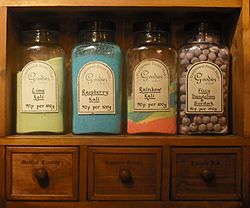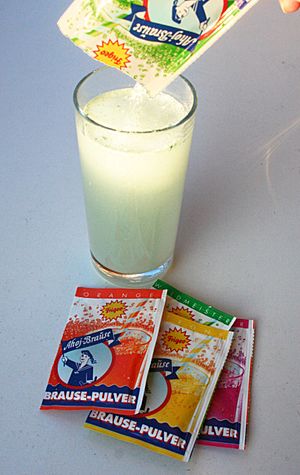Sherbet (powder) facts for kids

Jars of colourful Kali in a sweetshop
|
|
| Alternative names | Soda powder |
|---|---|
| Type | Confectionery |
| Main ingredients | Sugar, flavouring, edible acid and base |
Sherbet is a fun, fizzy, and sweet powder. People usually eat it by dipping a lollipop or liquorice stick into it. You can also just lick it straight from your finger!
Contents
What is Sherbet?
The word "sherbet" comes from the Turkish word şerbet. This word originally meant "a drink" in Arabic. Long ago, sherbet was a cool, fizzy, or iced fruit drink. Over time, its meaning and how it's spelled changed in different countries.
It's important not to confuse this fizzy powder with the "sherbet" found in North America. There, "sherbet" is a type of frozen dessert, similar to sorbet.
The History of Fizzy Sherbet
Fizzy sherbet powder became popular in the 1800s. People would often mix a spoonful of the powder into water to make a sparkling drink. They were told to drink it quickly while it was still bubbling!
Sometimes, people would put the powder directly into their mouth and then drink some water. This made it fizz right there! Before fizzy drinks in cans became common, sherbet was used to make many sparkling beverages. Today, we mostly know sherbet as a sweet powder.
What is Sherbet Made Of?
Sherbet in the United Kingdom and other Commonwealth countries is a fizzy powder. It contains sugar, flavouring, and two special ingredients: an edible acid and a base.
The acid can be things like tartaric, citric, or malic acid. The base is often sodium bicarbonate (which is also known as baking soda). When these powders touch moisture, like your saliva, they react. This reaction creates tiny bubbles, making the sherbet fizz! Lots of sugar and fruit flavouring are added to make it taste delicious.
Popular Sherbet Sweets
Sherbet can be enjoyed on its own or used to decorate other candies. People often judge sherbet by how fine its powder is, its colour, how "zingy" (acidic) it tastes, and its flavour, which is usually a citrus fruit.
Sherbet Lemon
Sherbet lemons are very popular sweets in the UK. They are hard boiled candies with a strong lemon flavour. Inside, they have a powdered sherbet center. When you suck on the candy, the sherbet inside slowly releases. This gives you a burst of intense lemon flavour that is both sweet and sour, with a fizzy, tangy kick!
Other sherbet fruit candies are also popular, like sherbet limes, strawberries, blackcurrants, raspberries, and orange. In the Harry Potter books, Albus Dumbledore loves sherbet lemons. He even uses their name as a secret password!
Sherbet Fountain
The Barratt's "Sherbet Fountain" has been around since 1925. It comes with a tube of sherbet powder and a liquorice stick. In the old paper packaging, you would bite off the top of the liquorice stick to make a straw. Then, you could suck the sherbet through it, and it would fizz and dissolve on your tongue.
Now, the Sherbet Fountain comes in a plastic tube with a solid liquorice stick. You can lick the sherbet off the stick or eat it directly. The packaging says "Sherbet with a liquorice dip."
Sherbet with a Lollipop
Sherbet dips, also called Sherbet Dabs, are another popular treat. The Dip Dab by Barratt is a good example. It's a packet with lemon-flavoured sherbet and a strawberry-flavoured lollipop. You can dip the lollipop into the sherbet, then lick it clean. You can also use the lollipop to spoon the sherbet straight into your mouth.
Flying Saucers
Flying saucers are small, round, edible paper discs. They are usually filled with plain white sherbet, similar to the kind found in Sherbet Fountains. These fun sweets were first made in the 1950s.
Images for kids




